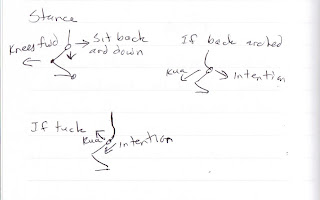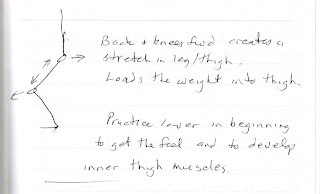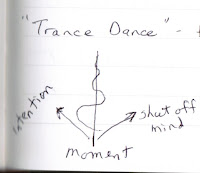* Question: I'm frustrated. I can feel different parts of my body but I can't feel how they are connected. How do I feel the parts connected?
Answer: Your questions may conceal the answer... but maybe not the answer you're expecting. Notice the tonality in your question. The "emotional place" you are asking from may be preventing you from noticing the answer. Notice the tonality behind your question and how it frames the question. Don't accept the frame of the question. Maybe you can change a word or two in the question and change the pacing of the question. Your questions, Mike, are usually based on mechanical and compartmentalized thinking. Changing a word, for example, from "parts" to "connections" will reframe the question positing a functional answer.
* Question: What's the difference between tension, pressure, peng? Aren't these different words for the same feeling?
Answer: Tension = contraction.* Question: So what's the feeling of peng?
Peng = pressure = expansion = eccentric movement with intention.
("Peng, and synonyms for "peng" can be understood differently depending on your level as well as misunderstood and hence, not practiced correctly if more fundamental structural tensions are not first resolved.
Answer: At an advanced level, the peng feeling feels empty but saying this to a beginner does not help guide the beginner to developing peng. Beginners must begin by developing feeling and a good place to start is developing a feel for proper zhan zhuang structure and later developing the feel of fascial stretch.
* Some students strive to repeat their teacher's path thinking this will take them to the level their teacher achieved. Their mistake in doing this is that they don't discover their own path and learning. Everyone has a different path. What is written in books and taught by teachers should be considered to be guide posts and road signs which cannot be exactly duplicated.
(I learned this lesson again at a recent Wujifa class. Basically, when I receiving an incoming force, a push and I unconsciously lock my shoulder in response thus blocking the force from going through, there is no way on earth any book or video would be able to identify this for me.
For example, a guide post or road sign is being able to relax and maintain structure under force. When it comes to my learning, I have to figure out how to resolve my bad habits and develop more functional habits.)
* There is a story about WWII pilots who survived after being shot down in the South Pacific islands. The local islanders would see the pilots talk into their radios and then split a coconut and hold coconut halves to their ears while speaking into a banana. In the same way, many people mimic the external appearances of the "internal arts" without understanding the internal technology.
* Question (after a zhan zhuang class): Why did you want me break my stance to wiggle around?
Answer: Wiggling is a medicine for you. You tend to be very methodical. You put everything in place and then you lock yourself into a particular posture. This approach is useful for beginners but you're not a beginner anymore. Wiggling is useful for you at this next level. Get yourself into place then wiggle and allow the posture to fall into place. Look for the feeling of what happened after wiggling, for example, you may notice, "Oh, that is less tight." or "Oh, this is looser." Those are functional, feeling-based roadsigns for you.
* Question: How do I get to that place (like Mr. D.) who feels his practice? I've been focusing recently on feeling the parts I can feel, like individual pieces. Recall the story of the pear. I am trying to construct a pear when what I want to do is taste the pear.
(The pear story goes like this... How would you describe a pear to someone who has never seen, felt, tasted, or smelled a pear before? If that person summed the pieces of your description, would s/he create the pear you described?)
Instructor: How do you describe a pear? Saying it is apple-like + sweeter + grainy does not equal a pear. You cannot add up individual descriptions and get a pear.
Eat rice. What is the flavor of rice after 5 chews? After 20 chews? After 60 chews? After chewing 3 minutes? After chewing 5 minutes? The more you chew rice, the more subtle are changes in flavor.
So in your practice ask yourself: What does connection feel like to you? The more you "chew on" the feeling, the more the feeling changes "flavor".
* Question to me: What is your feeling about stance practice?
My answer: Incredibly boring. Not enjoyable at all. In fact, I'm envious of those who say they enjoy zhan zhuang and look forward to zhan zhuang practice and find some pleasure in the feeling of their practice. I'm obviously still missing something. I'd like to get to the point where I can feel and stance practice becomes enjoyable.
(Interesting I would write this because I have had some truly amazing feeling experiences of connectedness and presence while practicing zhan zhuang. The question is, why do I stop? Why, when I have these breakthrough experiences and I see the path clearly before me, why do I say, "That's amazing!" and then look for something else, some other problem to resolve, etc.. ? Why do I choose what I do?)
* For me, transitioning from a method-based practice to a feeling-based practice is like going through a tunnel. It can be really boring and it can be intensely emotional.
* Question to me: What do you find interesting or intriguing about zhan zhuang stance practice?
My answer: The possibility of a fulfillment of a long-ago fantasy to have a kind of kung-fu strength without being muscularly bulky.
(What really keeps me going these days is seeing amazing advancement in my school brothers. Seeing where they were even a few months or weeks ago and where they are now really inspires me to rededicate my effort in a new way.)
Further reading:
Introductory article explaining this "Journal Notes" series: Zhan Zhuang Training Journal
Previous article in this series: Sitting Back and Down: Journal Notes #75
Next article in this series: - Toward a Feeling-Based Understanding: Journal Notes #77










